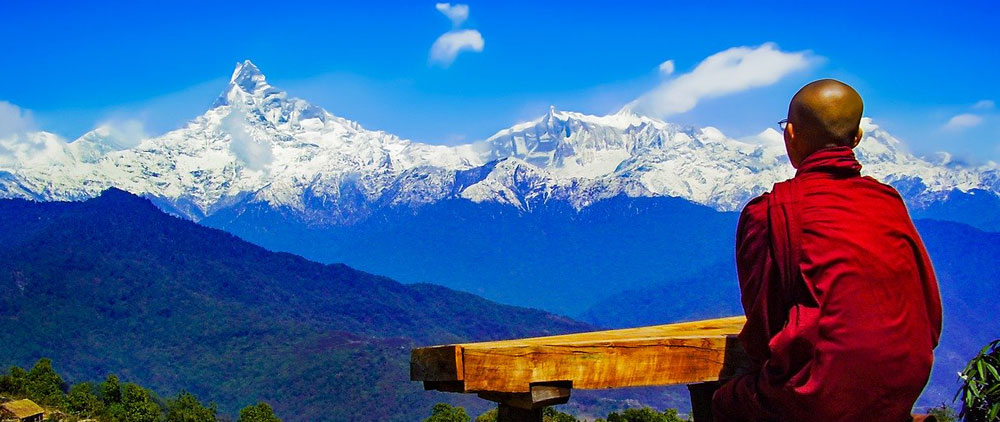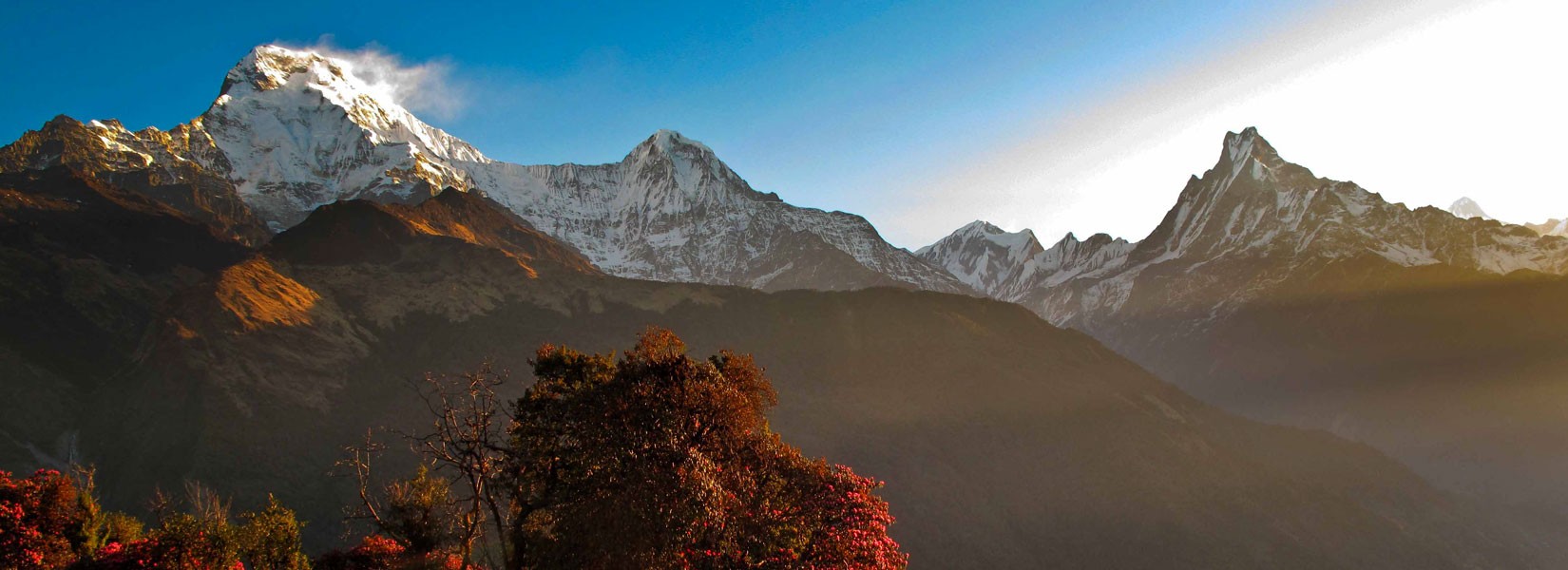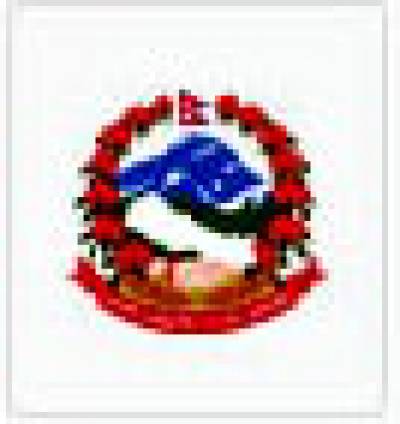JOMSOM MUKTINATH TREK
HAS EVERYTHING, FROM THE DEEPEST GORGE, GURUNG VILLAGES, FAMOUS TEMPLES & POON HILL’S PANORAMIC VISTA OF MAJESTIC SOARING SNOW CAPPED PEAKS.
The Jomsom Muktinath Trek has so much to offer with its spectacular views of much gigantic snow-covered peaks and rugged high altitude plains in Mustang, view of the incredible rugged terrain, famous temples and monasteries, and the remote other-world Mustang valley. Mustang in Tibetan means "Plain of Aspiration."
The trek to Jomsom Muktinath begins at Pokhara before heading through the Kali Gandaki Valley alongside the river and ultimately reaches the holy temple at Muktinath. The Kali Gandaki Gorge is the deepest in the world. The Kali Gandaki river source is at the border with Tibet at an elevation of 6268 meters at the Nhubine Himal Glacier in the Mustang region of Nepal.
The Jomsom Muktinath trek starts at Nayapul toward Muktinath via Tikhedhunga and Ghorepani. This is the preferred starting point. The second option is to drive to Beni first, via Nayapul, and either start trekking or continue to drive to Muktinath via Tatopani (hot spring). The 3rd option is to fly to Jomsom and trek to Muktinath which is one of the shorter trekking itineraries in Nepal. If you have enough time Sherpa Expedition and Trekking strongly recommend you start your trek from Nayapul - the first option. Even though the road is accessible from Beni to Jomsom/Muktinath, it is still worthwhile taking this trek up to Muktinath as there are not many vehicles on the road and it is also possible to follow the old trekking trails for part of the way.
If you start trekking via Nayapul through Tikhedhunga – Ghorepani – Tatopani (hot spring) you will reach Poon Hill (3210m) which has a well-deserved reputation as one of the most popular trekking routes in Nepal. Poon Hill is well known as a viewpoint of many famous snow-capped Himalayan peaks – especially at sunrise. From Poon Hill, the trail descends to Tatopani hot spring (means hot water in Nepali). The trail winds its way down to the Kali Gandaki Gorge and passes Dana Village and passes the Dhaulagiri Icefall (glacier) passing the village of Larjung. On the way to Jomsom, we pass several Thakali villages. On reaching Jomsom we follow the Kali Gandaki River heading in a northerly direction to Kagbeni on the way to Upper Mustang, referred to as an ancient kingdom. From Kagbeni the trail continues in a northerly direction to Muktinath passing through the village of Jharkot (3519m), a unique place lost in time! After reaching Muktinath we will spend a day exploring the village and visiting its Vishnu temple that is holy to Hindus and Buddhists and one of the highest temples in Nepal. We leave Muktinath and descend to Jomsom via the quaint village of Lupra. The next morning we leave Jomsom and fly to Pokhara.
Key Features of Jomsom Muktinath Trek
- 15-minute scenic mountain flight from Pokhara to Jomsom.
- Amazing Kali Gandaki Gorge and river with fossils embedded in its banks.
- Local culture and spiritual experience of the region including famous Vishnu Tempe..
- Amazing views of Annapurna and Dhaulagiri Massifs.
- Trek through a diverse rich landscape of flora and fauna.
- Tatopani Hot Springs.
- Muktinath Temple – holiest in Nepal for Hindus & Buddhists.
ITINERARY
Day 1 : Arrival at Kathmandu and transfer to hotel.
Sherpa Expedition & Trekking staff will be there to greet you at Tribhuvan International Airport and take you to your hotel, followed by a briefing covering information, dos and don’ts of your trek. Your safety and comfort are paramount.
Day 2 : Drive from Kathmandu to Pokhara (8,50m) Duration: 6-7 hours.
Our journey begins with a 6-7 hour drive toward the Pokhara Valley and its beautiful Phewa Tal (lake) and then checking in to your hotel close to Phewa Tal. There is plenty to see and do along Lakeside with its many shops, bars, and restaurants to choose from.
Day 3 : Drive from Pokhara to Nayapul & trek to Tikhedhunga (1,570m) Duration: 5-6 hours.
We will drive around 1:25 hrs from Pokhara via attractive Lumle village perched on the mountainside and then on to Nayapul (1050m). The Poon Hill trek begins at Nayapul and after a 30-minute trek along the banks of the Modi Khola (river) reach Birethanti where you will be asked to your tourist permit at the checkpoint. The trail takes us through the beautiful rhododendron forest and then follows the Modi River with a stop at a teahouse along the way, and after a 3 -4-hour trek reach the lush green village of Tikhedhunga.
Day 4 : Trek from Tikhedhunga to Ghorepani (2,874m) Duration: 6-7 hours.
Our trek today starts with a 2 hour fairly steep climb up to Ulleri (2070m) and then to the Magar village of Banthanti from where we are blessed with magical views of Mt. Machapuchare (6997m), Hiunchuli (6441m) and Annapurna South (7219m). After following the trail through a lush pink flowering rhododendron forest we cross a small bridge before reaching the village of Ghorepani where enormous peaks, such as Dhaulagiri, Annapurna South, Hiunchuli, and Annapurna loom in the background. This is a fantastic place to sit and take in the exquisite views.
Day 5 : Hike up to Poon Hill viewpoint (3,210m) & trek to Tatopani (1,190m) Duration: 6-7 hours.
Poon Hill is justifiable well known for offering unheralded views of the Annapurna Ranges – especially at sunrise and sunset. An early start will see us reach the Poon Hill viewpoint where we can watch the changing colors reflecting off the mountains, such as Dhaulagiri (8167m), Annapurna I (8091m), Annapurna II (7937m), Annapurna III (7855m), Annapurna IV (7525m), Annapurna South (729m), Nilgiri (6940m), Tukuche (6920m), Varaha Shikhar (7847m) & Lamjung Himal (6931m). After sending your camera into overdrive we will return to a well-deserved breakfast at Ghorepani, after which we head to Tatopani Village via the scenic trail passing through Deurali (meaning a ridge in Nepali) and teahouses until we reach Tatopani. Overnight stay at the teahouse.
Day 6 : Trek from Tatopani to Ghasa (2,010 m) Duration: 5-6 hours.
The trail today heads up the Kali Gandaki Gorge, believed to be the deepest gorge in the world, wedged between the two enormous 800 meter peaks of Annapurna and Dhaulagiri. The steadily rises up to Dana at 1400 meters and then on to Rupse Chhahara at 1550 meters where a beautiful waterfall cascades down into the river. Crossing to the eastern bank of the river we continue on the trail until we reach a suspension bridge and cross it to Kopche Pani a small Magar village famous for its temple on the hill (2121m). We then have a short climb to Ghasa where we stay the night.
Day 7 : Trek from Ghasa to Tukuche (2,586m) Duration: 5-6 hours.
Today we cross over to the eastern bank of the river and follow the trail along the riverbank until again crossing back to the west side before arriving at Larjung (2560m) nestled at the base of the mountains and with a stunning backdrop of the massive Annapurna Ranges. We follow the trail until we reach the village of Khobang alongside the Kali Gandaki River. with its narrow alleyways. Then we spend overnight at the ancient Thakali village of Tukuche at 2,590 m. Overnight at a guesthouse.
Day 8 : Trek from Tukuche to Kagbeni (2,810m) Duration: 5-6 hours.
Today we leave Tukuche and follow on the edge of the valley to Jomsom (2743m). Jomsom is a large settlement and administrative center of the Mustang region, with all administrative buildings you would expect in such a town i.e airport, army camp, hotels, shops, banks, and government offices. We continue our trek crossing to the eastern side of the river and follow the trail until we reach Eklai Bhatti (2730m). where the fork on the trail branches east to Muktinath and Thorong La Pass (5416m). We then take the trail along the river to Kagbeni (2810m) which is located at the junction of the Jhong Khola & the Kali Gandaki (rivers). Kagbeni is a fascinating village with its definitive Tibetan culture and amazingly friendly villagers with broad smiling faces. Tonight we stay at Kagbeni.
Day 9 : Trek from Kagbeni to Muktinath (3,802m) Duration: 4-5 hours.
The trek today begins with a relatively steep ascent up the Jhong Khola valley until we reach a crossroads at which we follow the trail to Muktinath located just below Khingar (3374m). The trail continues along the higher banks of the Jhong Khola (river) until we reach the intriguing village of Jharkot (3500m) worth taking some time to explore and stop for lunch.. Leaving Jharkot we continue on to Muktinath. We first arrive at Ranipauwa, a thriving small village with many teahouses and shops not far from Muktinath. Further on the trail takes us to Muktinath (Tibetan - Chumig Gyatsa) famous for its Vishnu temple, sacred to both Hindus and Buddhists, located in Muktinath Valley at the foot of the Thorong La mountain pass. It is claimed to be one of the world's highest temples. Many Buddhists and Hindus, as well as sadhus (holy men) from India, make a pilgrimage here. Taking a bath in these 108 waterspouts and two Kunda (ponds) is believed to bring salvation. Tonight we stay at Muktinath.
Day 10 : Visit Muktinath Temple and trek to Jomsom (2,750m) Duration: 5-6 hours.
From Muktinath, we pass through lush meadows, fruit trees, and streams passing through Kagbeni before we reach Jomsom in the Kali Gandaki valley. We take a short detour today to Bon Punt monastery in Lubra. Bon-Po is said to be older Buddhism and Lubra, with just 14 families is one of the few Bonpo villages in Nepal. The trek today will take around 6 hours. Kagbeni has a well-deserved reputation for its horticulture industry.
Day 11 : Drive from Jomsom to Pokhara (820M) & drive to accommodation; Duration: 6-7 hours
Today we drive through the Kali Gandaki Gorge, hemmed in by the enormous mountain ranges and Mt. Annapurna and Mt. Dhaulagiri. Once back at Pokhara Sherpa Expedition & Trekking staff will take you to your hotel where you can rest or wander around Phewa Tal (lake), or maybe stroll along lakeside and enjoy a cold drink or coffee at the numerous cafes.
Day 12 : Drive from Pokhara to Kathmandu; Duration: 6-7 hours.
Today we head back on a 6 to 7 hour drive to Kathmandu with many fond memories of Nepal and its unique culture and geography. These memories will last a lifetime!
Day 13 : International departure from Kathmandu Airport.
Sherpa Expeditions & Trekking staff will transfer you to the airport for your final departure from Nepal. We hope that this epic trek will be firmly ingrained in your memory and will be enough to prompt you to consider your next trek with us!
SERVICES
COSTS INCLUDED
- All airport pick-up & drop off by private vehicle (international)
- Two night’s standard twin sharing Hotel in Kathmandu with breakfast.
- Two night’s standard twin sharing Hotel in Pokhara with breakfast.
- Annapurna Conservation Area Permit and Trekkers’ Information Management System (TIMS card)
- English speaking, government licensed guide with all his salary, food, drinks, accommodation, transport and insurance
- Trekking Lodge (Tea House) accommodation during the trek.
- Three meals a day; breakfast, lunch, and dinner during the trek
- Use of sleeping bag, down jacket, duffel bag and walking poles (if you don’t have your own, to be returned after trip completed).
- Private transportation from Pokhara - Nayapul
- Jomsom to Pokhara transportation by Bus
- Bus transportation from Kathmandu to Pokhara and back to Kathmandu.
- An arrangement of emergency evacuation service (should have insurance for emergency evacuation and will be paid by your travel insurance company)
- All necessary government taxes and service charges
- Strong, helpful Sherpa porters with proper safety equipment and walking equipment, his salary, food, accommodation, and insurance (one porter for two people).
- Sherpa Expedition and Trekking T-shirt
- Trip achievement certificate after successful trip completion.
- Oxygen meter to check your pulse and oxygen saturation and heart rate twice daily (Very useful to check Altitude Mountain Sickness(AMS) symptoms) which will ensure your health during the trek.
- Assistant guide for groups of 8 or more people.
Costs Exclude
- Meals whilst you are in Kathmandu & Pokhara - lunch, and dinner.
- Nepal entry visa fee (easy to obtain the visa on arrival at Tribhuvan International Airport – Kathmandu). $30 USD for 15-day, $50 USD for 30 Days, and $125 USD for 90 Days visa.
- Personal travel and medical insurance.
- International airfare.
- Your personal expenses.
- All the alcoholic and nonalcoholic, soup, tea, coffee, hot chocolate, cocoa, mineral water, extra food, cold and hot drinks on trek ( i.e. those you choose to purchase along the way and during evenings in the tea houses)
- All desserts & sweet things like chocolate, cake, pie, pudding.
- Hot shower and battery charging at the tea houses.
- Tips for the guide, porter, and driver (tipping is expected)
- NOTE: If you return earlier from the trek due to sickness or any problem, the money you paid for the flight, hotel, mountain room, food, etc. is nonrefundable, and you will need to bear the expenses for the hotel, food, etc. in Kathmandu yourself.
EQUIPMENTS
The following information will give you some idea about what you need to bring for the trek. It is important you do not forget the essential items, as this will determine your comfort and safety on the trek. Equally important is that you do not burden yourself with unnecessary equipment on the trek.
General
- All season sleeping bag and down Jacket (we can provide if you need it, but has to be returned after the trek)
- Duffle bag ( Sherpa Expedition & Trekking provide duffle bag during the trek but has to be returned after the trek)
- A wind and waterproof thin layered jacket (a must-have for morning and evenings above 3,000m)
- Daypack
Upper Body- Head / Ears / Eyewear
- A pair of half gloves
- A warmer hat that covers the ears
- Sunglasses
- Neckwarmer
- Sunscreen (35 to 60 SPF)
- Headlamp and an extra set of batteries
Hands
- A pair of half gloves for walking poles(if you prefer)
- Warmer shell gloves and liner
Upper Body
- long sleeve t-shirts
- Thermal tops
- wool jacket or pullover
- Sports bras for women and girls
- Water and windproof shell jacket
Lower Body
- Thermal underwear (especially trousers)
- windproof and waterproof trousers
- warmer trousers
- Comfortable trekking pants
- Extra casual sport pants
Footwear
- A pair of good waterproof trekking boots
- Pair of sandals
- 4-5 pairs of woolen socks
- Sock liners
- Light shoes and sneakers
- First Aid Kits and Medicines
- Assorted adhesive bandages (fabric preferred)
- Blister treatment cream or similar
- Insect / anti-itch ointment
- Ibuprofen or other pain-relief medication
- Diamox (125mg to 250mg tablets for altitude sickness)
- Warps, splints, and wound coverings butterfly bandage
- Water purifying pills
(Note our company guide will carry the medicines and first aid kits during the trek. However, we recommend you bring your personal first-aid kit as well)
Miscellaneous - but must useful on the trek
- 4 passport size photos with original passport
- Water bottle & filter
- Flight details (please make a copy and leave one pic at our office in KTM because in case you want to change your flight date)
- Bathroom kit (conform, should be included toilet paper, plastic bags, hand wipes, towel, and soap, etc.)
Extra things
- Comfortable trekking poles
- Quality energy dry foods (up to you)
- Power bank and music players
- Camera (memory card, chargers, and extra batteries)
GOOD TO KNOW
Accommodation
You will be accommodated in 3-star hotels in Kathmandu. During the trek, we will be staying at lodges/ teahouses. You may find comfortable and better quality Eco lodge/hoestay- having attached bathroom at lower levels- until you reach higher elevations, where the accommodation is more basic with bare necessities.
Meals during the trek
In Kathmandu, your hotel includes breakfast, whereas all meals (breakfast, lunch, and dinner) will be provided during the trek. A staple food of the Manang & Mustang regions is potatoes, oats, buckwheat, Sherpa stew, and Tibetan bread. Sherpa’s’ started farming potatoes when the first seeds were introduced to the region in the early 90s. There is a limited choice of food at higher elevations and except many potato dishes. Potatoes are high in carbohydrates – an excellent source of energy needed at high altitudes.
Transportation
We use a private car for sightseeing and for the airport to hotel pick and drop off. We use public transportation or local buses during the trek.
Physical fitness
This can be a challenging trek where you often have to walk 6-7 hours a day. You don’t need past experience of hiking or trekking but if you have done any kind of trekking activities then it is always a plus! We have met people from all walks of life, shapes, and sizes who have completed the trek. The only difficult part is when altitude sickness strikes and the effect that it can have on your body. Before leaving for Nepal it is good if you can prepare yourself physically by increasing your stamina and oxygen intake.
Remember – The better prepared – the more enjoyable your trek!
MAP
PHOTOS/Videos
Departures
Select a departure month
Fill out the form below and a Travel Expert will reach out to create your perfect tour.
FAQS
What is the Jomsom Muktinath Trek?
The Jomsom Muktinath Trek is a popular trekking route in the Annapurna region of Nepal. It takes you to the sacred Hindu and Buddhist pilgrimage site of Muktinath, located at an altitude of 3,800 meters. The trek starts from Jomsom, a town in the Mustang district, and offers stunning views of the Annapurna and Dhaulagiri mountain ranges.
How long does the trek take?
The duration of the Jomsom Muktinath Trek typically ranges from 7 to 10 days, depending on your itinerary and pace. The trek can be customized to fit your preferences and time constraints.
What is the best time to do the trek?
The best time to do the Jomsom Muktinath Trek is during the spring (March to May) and autumn (September to November) seasons. These months offer stable weather conditions, clear skies, and moderate temperatures, making it ideal for trekking. However, the trek can also be done in the winter and summer months, but the weather conditions may be more challenging.
Do I need a permit for the trek?
Yes, you will need permits to do the Jomsom Muktinath Trek. The required permits are the Annapurna Conservation Area Permit (ACAP) and the Trekkers' Information Management System (TIMS) card. These permits can be obtained in Kathmandu or Pokhara before starting your trek.
What is the difficulty level of the trek?
The Jomsom Muktinath Trek is considered a moderate trek. It involves trekking through various terrains, including uphill and downhill sections, with an average of 5-6 hours of walking per day. While it is not technically challenging, a good level of fitness and some prior trekking experience is recommended.
What are the accommodation and food options along the trek?
The Jomsom Muktinath Trek offers a range of accommodation options along the route, including teahouses and guesthouses. These establishments provide basic amenities such as a bed, blankets, and food. The food options vary from local Nepali dishes to international cuisine, and vegetarian options are also available.
Is it possible to do the trek independently or do I need a guide?
The Jomsom Muktinath Trek can be done independently, as the trail is well-marked and there are teahouses available for accommodation. However, hiring a guide or joining a trekking group is recommended, especially if you are new to trekking or unfamiliar with the area. A guide can provide valuable information, assist with navigation, and ensure your safety during the trek.
Are there any altitude-related risks on the trek?
Altitude sickness is a concern on the Jomsom Muktinath Trek, as you reach higher altitudes. It is important to acclimatize properly, stay hydrated, and ascend gradually to minimize the risk. If you experience symptoms of altitude sickness, such as headache, nausea, or dizziness, it is essential to descend to a lower altitude and seek medical help if necessary.
What should I pack for the trek?
Some essential items to pack for the Jomsom Muktinath Trek include sturdy trekking boots, warm clothing layers, a good quality sleeping bag, a daypack, a water bottle, sunscreen, a hat, sunglasses, a first aid kit, and toiletries. It is advisable to pack light and carry only the necessary items.
Can I hire porters to carry my backpack?
Yes, if you prefer not to carry your backpack during the trek, you can hire porters to carry your belongings. This allows you to trek with less weight and enjoy the journey more comfortably. You can arrange for porters through trekking agencies or directly with the teahouses along the route.
Latest Traveller’s Reviews
Travel experiences of our clients who recently returned from their trips.
100%
Based On 9 Reviews
Jakson David
Australia
December 13, 2023
Lower Mustang Trek!
I highly recommended this tour! What a fantastic trip. Scenery so varied, views for days and days! Guides friendly and knowledgable. Wouldn't change anything - thank you!
Brenda Simmons
Austria
December 7, 2023
A Fantastic Trekking Adventure
We recently had a fantastic trekking adventure doing the Jomsom Muktinath trek with Sherpa Expedition. The trip was absolutely amazing, with diverse scenery and breathtaking views that we will never forget. The guides were friendly and knowledgeable, making the experience even more special. We highly recommend this tour!
Vicky Erickson
Austria
November 1, 2023
A Memorable Experience
My partner and I had a memorable experience doing the Jomsom Muktinath trek with Sherpa Expedition. The trip was fantastic, with varied scenery and incredible views that seemed to go on for days. The guides were friendly and knowledgeable, making the journey even more enjoyable. We highly recommend this tour!
People Considering This Package Right Now Check availability
























